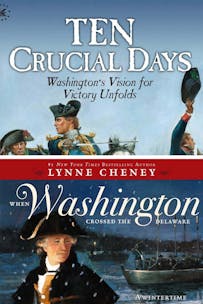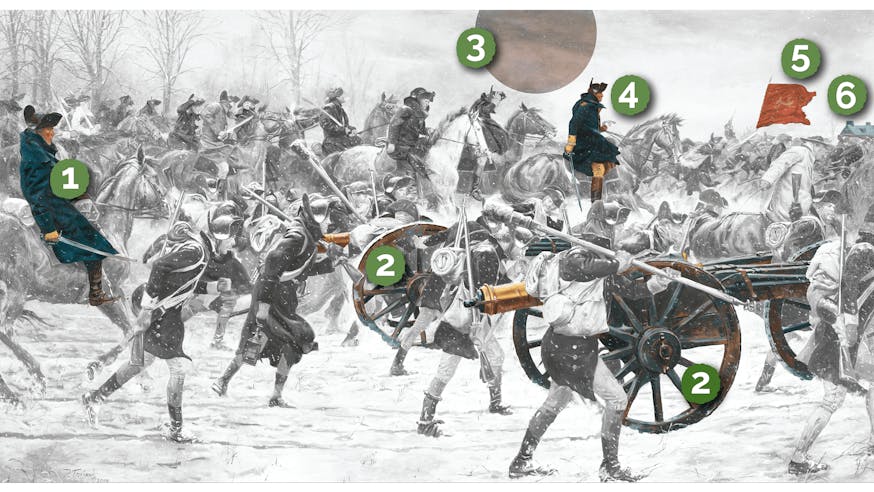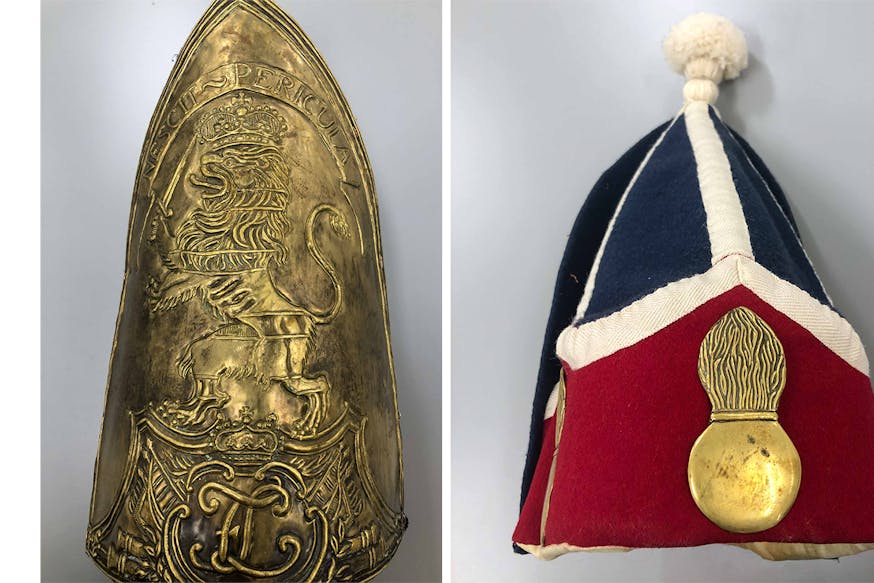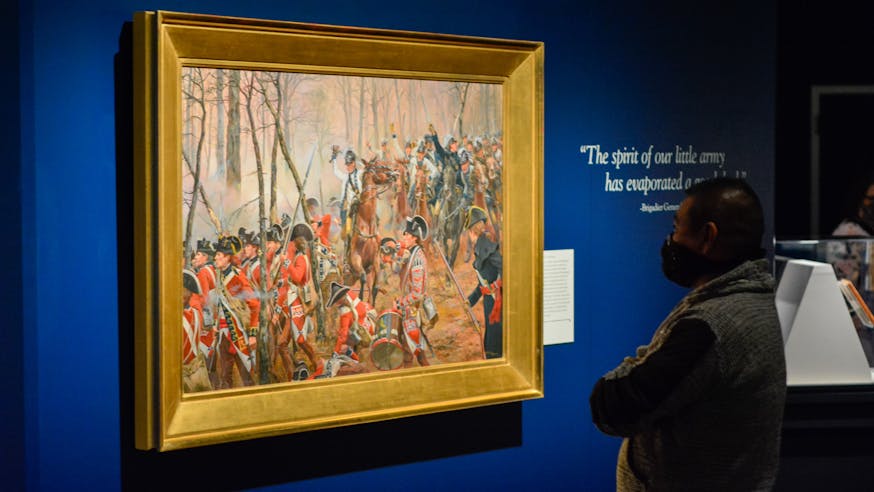Read the Revolution
Double Feature: Countdown to the 10 Crucial Days
December 15, 2021
Purchase the books from Simon & Schuster.
By December 1776, only six months after the Declaration of Independence was signed, many Americans felt that the Revolution was on the verge of defeat. However, in a series of actions that historians call the “10 Crucial Days,” the cause got a second chance. Starting on Wednesday, Dec. 25, 1776, General George Washington’s army crossed the Delaware River from Pennsylvania into New Jersey. From the crossing, troops marched overnight towards Trenton. Only a few days after a dramatic victory there, Washington engaged the British at the Battle of Princeton on Friday, Jan. 3, 1777.
Historian William L. Kidder provides a blow-by-blow account of the campaign in The Ten Crucial Days: Washington’s Vision for Victory Unfolds, when Washington made and modified plans “to turn the psychological — if not the strictly military — situation completely around.” Kidder tells readers what made this campaign crucial for Washington, military leaders, and ordinary people who saw military action in Pennsylvania and New Jersey, but also for armies in other parts of America, Britain, and France. Read an excerpt from Chapter 5 for a glimpse at Washington’s initial plan.
Excerpt - Ten Crucial Days
As the campaign drew to a close, Washington believed that even just one victory would do more than anything else “to eradicate the stain of his recent mistakes.” That belief focused his thoughts as he had retreated across New Jersey constantly contemplating turning around to attack his pursuers, but not doing so because he never had enough men and General Lee made no effort to reinforce him.
To prevent British pursuit after the retreat across New Jersey, Washington had issued similar orders to several units to gather up all boats on the Jersey side of the Delaware River north and south of Trenton for many miles and remove them to the Pennsylvania side after all his men and supplies got across at the two Trenton ferries. All boats were to be secured where they would not be seen by British patrols along the New Jersey side, but where they would be available to carry groups of men back across to New Jersey on harassing attacks.
While in the middle of transporting his army’s supplies across the Delaware at Trenton, Washington wrote to John Hancock on December 5 expressing his frustration with retreating out of New Jersey. He wrote, “I conceive it to be my duty, and it corresponds with my inclination, to make head against them, so soon as there shall be the least probability of doing it with propriety.” Once in Pennsylvania, Washington established a string of camps between Coryell’s Ferry (modern New Hope, Pennsylvania) and Bristol ordering each to guard the crossing points and observe British movements, especially watching for any evidence of assembling boats. Howe made no effort to obtain boats from the rivers to the east or the Royal Navy at New York and by December 14 had decided to take up winter quarters and put off advancing on Philadelphia until spring.
Skeptical of Howe’s intentions, and not content to end the campaign with a retreat, Washington wanted to “attempt a stroke upon the forces of the enemy, who lay a good deal scattered,” understood to be about 4,000 at Brunswick, 3,000 at Princeton, 1,500 at Trenton, and 1,500 at Bordentown. Encouraged that the British cantonments were vulnerable, his urge to attack them was only tempered by the reality that he badly needed reinforcements in order to undertake anything significant and the enlistments of a large portion of his troops ended on December 31. He did not expect these men to reenlist and their departure would leave him with only “a few southern regiments, almost reduced to nothing by sickness and fatigue.” He continued to believe that General Howe’s troops “close upon my front” were merely waiting for his army to dissolve when they could easily conquer Pennsylvania, just as they had New Jersey. Nineteen-year-old Major James Wilkinson noted in his memoirs that he saw Washington “in that gloomy period, dined with him and attentively marked his aspect; always grave and thoughtful, he appeared at that time pensive and solemn in the extreme.”
Washington and at least some of his generals were already thinking about ways to redeem the 1776 campaign by retaking at least part of New Jersey. Two or three days after the army crossed to Pennsylvania, Major John Armstrong, an 18-year-old aide-de-camp to Brigadier General Hugh Mercer, overheard several conversations between Mercer and Adjutant General Joseph Reed discussing whether it would be possible, or advisable, to attack and destroy some or all of the enemy cantonments. They agreed action should be pursued and each took responsibility for bringing up the subject with Washington and those officers likely to be part of any council of war.
Washington welcomed their conversations and by December 14 was working through various options when he wrote to General William Heath that, “I should hope we may effect something of importance, or at least give such a turn to our affairs as to make them assume a more pleasing aspect than they now have.” To Governor Trumbull of Connecticut he suggested that, “A lucky blow in this quarter, would be fatal to them, and would most certainly raise the spirits of the people, which are quite sunk by our late misfortunes.” To General Gates, believed to be bringing him reinforcements from Ticonderoga, he wrote, “If we can draw our forces together, I trust, under the smiles of providence, we may yet effect an important stroke, or at least prevent Genl. Howe from executing his plans” regarding Philadelphia.
The many conversations no doubt included multiple scenarios for possible actions and while Washington may have hoped for secrecy, by December 18, Philadelphian Christopher Marshall had heard “news that our army intended to cross at Trenton into the Jerseys.” On December 19, General Nathanael Greene sent a note to General James Ewing from “Bougarts Tavern” in Buckingham Township relaying Washington’s request for 16 Durham boats and four “flats,” i.e. ferry boats, to be sent down to McConkey’s Ferry “as soon as possible” under the “care and direction of some good faithful officer.” This indicates that Washington was planning a major re-crossing of the Delaware by his army, not just another harassing raid.
Two days later Major General Nathanael Greene wrote to Governor Nicholas Cooke of Rhode Island from Coryell’s Ferry that they would “give the enemy a stroke in a few days. Should fortune favor the attack perhaps it may put a stop to General Howes progress.” Robert Morris in Philadelphia wrote to Washington the same day that, “I have been told to-day that you are preparing to cross into the Jerseys. I hope it may be true.”
Between December 8 and 25, Washington gathered intelligence on the British and Hessian troops and cantonments and pondered how he could attack and defeat some portion of them with his small army. Howe had established his cantonments across New Jersey to support and encourage the Loyalists and Washington believed he must now force the enemy troops out of New Jersey in order to revitalize the Whigs. Washington’s plan for the December 26 attack, to launch a short campaign to drive the British from as much of New Jersey as possible, developed over time from conversations with various officers and analyzing multiple intelligence reports. He might capture Trenton in a day with a surprise attack, but that would only be a symbolic victory if he could not follow it up with additional actions and retreated back to Pennsylvania. But, unless he could convince his troops to extend their enlistments, he would only have one short week to accomplish anything larger before his army became even more a shadow of its former strength. He was running out of time and resources.
William L. Kidder, Ten Crucial Days: Washington’s Vision for Victory Unfolds (Knox Press, 2020), 88-90.
Sign Up!
Get biweekly Read the Revolution featured excerpts right to your inbox.
The decisions Washington and others made in this crucial campaign are illuminated for young readers in When Washington Crossed the Delaware: A Wintertime Story for Young Patriots. Author Lynne Cheney and illustrator Peter M. Fiore captivate kids aged 5-9 with paintings paintings that illuminate these ten days of the war’s dark hours as well a a map, source index, and exciting quotations. Eyewitnesses included 10-year-old Martha Reed, who remembered the sound of gunfire in Trenton on one December morning, and, in this excerpt, a Revolutionary officer recalling a winter’s night.
Excerpt - When Washington Crossed the Delaware
“This night we lay amongst the leaves without tents or blankets.”
-Enoch Anderson
Captain, Haslet’s Delaware Regiment
In early December the Americans made it across the Delaware River into Pennsylvania. Under General Washington’s orders they had taken every boat they could find with them, so they knew they were safe from the British for a while. But they were sick, exhausted, and cold.
Event when the struggle seemed hopeless, George Washington did not give up. On the other side of the river the British had stationed Hessians — German soldiers the British had hired to fight them. The Hessians didn’t have much respect for American soldiers. They didn’t think the Americans would do anything bold or daring — and so George Washington decided on a bold and daring course.
He called a meeting of his generals and worked out a plan. On Christmas night American troops would cross the Delaware River in several different places. Before dawn on December 26 they would attack the Hessians at Trenton, New Jersey.
Washington warned his officers to keep the plan a secret. It could only succeed, he believed, if the Americans caught the Hessians by surprise.
Also crucial to success was the spirit of the American troops. Beaten down as they were, could they fight another battle?
Lynne Cheney, with paintings by Peter M. Fiore, When Washington Crossed the Delaware: A Wintertime Story for Young Patriots (Simon & Schuster/Paula Wiseman Books, 2012).
Read the Revolution is sponsored by The Haverford Trust Company.
Read the Revolution is published biweekly by the Museum of the American Revolution to inspire learning about the history of the American Revolution and its ongoing relevance.
Tags
Learn More

Breaking Down Don Troiani's "Victory or Death, Advance on Trenton" Painting

Hessians and the 10 Crucial Days Discovery Cart


